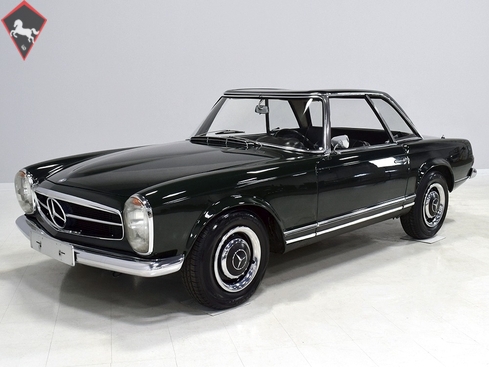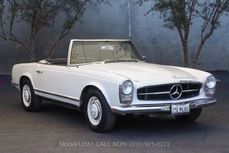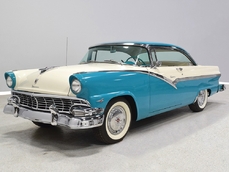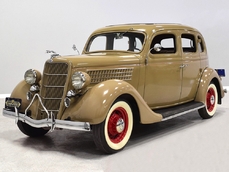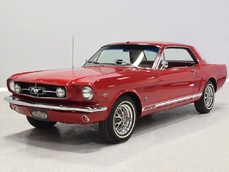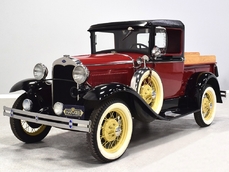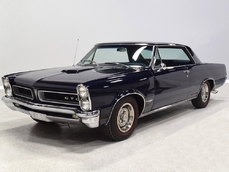Mercedes-Benz 250SL w113 2.5 liter inline-6 1967
General description :
Relevant details: Euro-spec 4-speed 250SL, matching-numbers engine documented by Mercedes-Benz data card, lifetime California car, the notches are intact, the spot welds are mostly visible despite a thick older repaint, and this is a rare and unusual California Coupe, which has a back seat but no convertible top.
OK, if you’re still here, then you’re obviously still interested in this lovely SL. You may be asking yourself, “What’s a California Coupe?” In late 1966, Mercedes-Benz decided to bolster the brand’s presence on the west coast of the United States, which was home to the booming car culture. The result was the California Coupe, a 250SL with a removable hardtop and a back seat, but no convertible top (the logic being, of course, that in California you wouldn’t need it). From all external appearances it is 100% SL, but when the top is off, you have a little extra room and thanks to a bit less weight, it offers a bit more performance, too.
We don’t know where this SL was originally delivered, but given the metric speedometer and the large B on the tail, we suspect it was perhaps Belgium. Shortly thereafter, it arrived in California, its namesake, where it spent the next 45 years. It wears its original color combination of Dark Olive paint with a black hardtop and matching black hubcaps, which makes it look understated and substantial, a look we like a great deal. It appears that it is a combination of original paint on the hood and deck, while the sides of the car have been repainted. Why, we can’t say, but the color match is quite good and aside from a thin spot on the hood where it has been buffed through, it looks great. Not perfect, but if you want a casual SL that’s easy to drive and offers no worries in the real world, it’s ideal. It doesn’t appear to have ever been hit or damaged, and panel fit is excellent, which is typical of the Pagoda. The all-important notches on the front fenders are clearly visible and while the repaint seems to have been thick enough to obscure some of the spot welds on the inner fenders, they’re still evident. Doors close with authority and both the hood and trunk lid fit flush with no issues. You will also note that the usual trouble spots in the rear valence under the bumpers are clean. The only possible issue might be a small rust spot near the jack spot on the right side rocker panel, but you really have to examine it closely to even see it.
The Euro-spec cars offer the handsome headlights that were designed for the car, not the homely US-spec lights that were a compromise with the Feds. There’s also a square fog light on the tail, another European feature, and without the US-spec overriders on the bumpers the design is extremely clean. There’s just no angle from which this car doesn’t look great.
We strongly believe the black leather interior is original, which speaks to the car’s excellent preservation. There’s some moderate wear on the driver’s seat but no splits, tears, or other damage, and it appears that even the carpets are original. The door panels are excellent and the wood on top of the dash is in very good condition, needing little more than some linseed oil to buff up to a soft shine. No cracks in the steering wheel or the dash pad, and yes, that’s a 4-speed manual shifter on the transmission tunnel. All the gauges are fully operational and you’ll note that the speedometer is measuring in KPH, not MPH. The Blaupunkt AM/FM/shortwave radio is an awesome addition and powers up, although we haven’t tested all its functions. The sliders for the heat/defrost are excellent and even the map light illuminates when you open the glove box. Sadly, the clock is not working, but it seems to be the only thing in the entire car that isn’t working as it should. A glance behind the front seats and you’ll see how the California coupe is different—a full-width bench seat that could probably accommodate adults for short trips but is probably best reserved for children. Better yet, it folds down to create a rather large parcel shelf which, combined with the trunk, offers quite a bit of space. And speaking of the trunk, it’s neatly finished with a proper mat, along with a factory jack assembly and tool roll. There is no spare tire, but it shouldn’t be difficult to find one if needed.
The removable hardtop is in excellent condition with a clean headliner, good chrome, and good weather seals. A folding hardtop stand is included with the car for alfresco driving.
The car is powered by its original, numbers-matching 2.5 liter inline-6, which makes for entertaining performance in the relatively lightweight SL. As far as we can tell, it has never been out of the car and runs superbly today. Turn the key and listen for the fuel pumps to pressurize the system, then kick the starter and let it fire up and idle on its own. After a second or two, it settles into an even 700 RPM idle and is ready to run. No noises, no smoke, and good oil pressure suggest the robust Mercedes-Benz engine is healthy and it pulls with genuine enthusiasm at almost any speed. It’s tidy under the hood, with mostly original finishes used throughout, correct fittings, and factory-style hardware. Aside from a few hose clamps and a replacement firewall insulator, it looks quite authentic. Recent work includes a new master cylinder, correct Bosch coil and distributor cap, as well as new plugs and wires. It’s 100% ready to run.
The desirable 4-speed manual transmission transforms the SL from pleasant little convertible to aggressive-feeling roadster. Clutch action is light and while the shifter is a bit vague, you won’t miss a gear and it feels familiar right from the start. Somewhat tall 3.92 gears in the independent rear end make it feel punchy around town and the six doesn’t mind spinning along at modern highway speeds. There’s a recent exhaust system that gives it that characteristic six-cylinder baritone wail and with both power steering and power brakes, it’s easy for anyone to handle. In addition to the master cylinder, the brake hoses, calipers, and pads are new, and there are fresh shocks at all four corners. The floors, rockers, and other critical areas show their California heritage with exactly zero issues—that’s factory undercoating on the floors, not rust or scale. This is a very solid SL. Factory 14-inch steel wheels with color-matched hubcaps carry new 195/75/14 radials that are so fresh you can still see the protective blue coating on the whitewalls inside.
We’ve sold a lot of SLs, and we like this one most of all. It isn’t the nicest, the most perfect, or the most valuable, but it drives quite well and the 4-speed completely transforms the Pagoda’s personality. If you can live without the folding soft top (which isn’t difficult), it represents a lot of Mercedes-Benz quality and an awesome pedigree for the money. Call today!
http://www.harwoodmotors.com/vehicles/inventory_details.php?id=882
1967 Mercedes-Benz 250SL w113 2.5 liter inline-6 is listed sold on ClassicDigest in Macedonia by for $69900.
Car Facts
Car type : Car Make : Mercedes-Benz Model : 250SL w113 Model Version : 2.5 liter inline-6 Engine size : 2.5 Model Year : 1967 Location : Ohio
Sold
Seller Information
Sold
People who viewed this Mercedes-Benz 250SL w113 also viewed similar Mercedes-Benz listed at ClassicDigest
Other cars listed for sale by this dealer
About Mercedes-Benz
In the annals of automotive history, the journey of Mercedes-Benz is a tale that unfolds with the ingenuity of its founding pioneers. In the year 1886, Karl Benz crafted the Benz Patent Motorwagen, a creation that would go down in history as the world's inaugural automobile. Unbeknownst to him, this moment marked the genesis of what would evolve into the most illustrious premium car manufacturer globally. The financial underpinning of this pioneering venture, interestingly, was provided by Karl Benz's wife, Bertha Benz, demonstrating a remarkable partnership that would set the tone for Mercedes-Benz's legacy.A parallel narrative emerged not far away, as Daimler-Motoren-Gesellschaft, founded by Gottlieb Daimler and Wilhelm Maybach, entered the scene. In 1901, they unveiled their automobile under the now-famous moniker "Mercedes," meaning "godsend" in Spanish. This name was bestowed upon the car at the behest of Emil Jellinek's daughter, the distributor for Daimler-Motoren-Gesellschaft. The wheels of innovation were set in motion.
Fast forward to 1926, a pivotal year that witnessed the merger of Daimler with Benz & Cie., culminating in the birth of Daimler-Benz. The amalgamation saw the adoption of "Mercedes-Benz" as the distinguished trademark for their automobiles, fusing the legacies of two visionary entities into one.
Contrary to perceptions of conservatism, the trajectory of Daimler-Benz unfolds as a chronicle of industry firsts. From the introduction of the honeycomb radiator to the float carburetor, and the pioneering implementation of four-wheel brakes in 1924, Daimler-Benz consistently pushed the boundaries of automotive innovation. The diesel-powered Mercedes-Benz 260 D in 1936 marked the inception of diesel engines in passenger cars. The iconic Mercedes-Benz 300SL Gullwing made history as the first car with direct fuel injection, albeit the Gutbrod's tiny 2-stroke engine can claim precedence.
Safety innovations became a hallmark, with Béla Barényi's patented safety cell design in the "Ponton"-models in 1951, featuring front and rear crumple zones. The W116 450SEL 6.9 saw the introduction of the Anti-Lock Brake system (ABS), another pioneering safety feature. From the first production airbags and beyond, the legacy of "firsts" continued to be etched into the fabric of Daimler-Benz.
Over its centennial journey, Mercedes-Benz has not merely produced cars but has sculpted automotive icons. The SSKL, 710 SSK Trossi Roadster, 770K Grosser, 540K Spezial Roadster, 300SL Gullwing, w100 600 Pullman, w111 280SE 3.5 Flachkühler, w113 230SL Pagoda, w109 300 SEL 6.3, and w201 2.3-16 Cosworth stand testament to the brand's commitment to engineering excellence.
The roaring Silver Arrows, or "Silberpfeile," including the W 25, W 125, W154, W165, and W196, created a legacy of dominance on the racetrack. These machines were not merely cars; they were expressions of precision, speed, and an indomitable spirit that left their competitors in the dust.
As Mercedes-Benz marches into the future, it does so not just as an automaker but as a custodian of a legacy, a torchbearer of innovation, and a beacon of automotive excellence. The road ahead is sure to witness the continued fusion of cutting-edge technology, timeless design, and an unwavering commitment to setting new standards in the world of automobiles.
One luminary figure who left an indelible mark was Béla Barényi, often heralded as the "father of passive safety" for his pioneering work in safety engineering. His patented safety cell design, featuring front and rear crumple zones, became a hallmark of Mercedes-Benz's commitment to occupant safety, setting new standards that reverberated throughout the automotive world.
Moving through the chronicles, the collaborative genius of Wilhelm Maybach, alongside Gottlieb Daimler, laid the foundation for Daimler-Motoren-Gesellschaft. Their innovations not only birthed the first Mercedes but established a culture of relentless pursuit of technological excellence that remains integral to Mercedes-Benz's DNA.
In the post-merger era of 1926, Ferdinand Porsche emerged as a prominent figure within Mercedes-Benz. His work on the Mercedes-Benz S-Type, a supercharged race car, garnered acclaim and set the stage for a legacy that extended far beyond the marque. Porsche's impact would later extend to his eponymous company, but his influence at Mercedes-Benz during those formative years was pivotal.
As the 20th century progressed, the legendary Rudolf Uhlenhaut emerged as a key figure. Uhlenhaut, an accomplished engineer and the driving force behind the iconic Silver Arrows, played a crucial role in Mercedes-Benz's dominance in motorsports. His engineering prowess and attention to detail were instrumental in creating some of the most formidable racing cars of the era.
In the latter half of the century, figures like Bruno Sacco, the head of design at Mercedes-Benz from 1975 to 1999, left an indelible imprint on the brand's aesthetic identity. Sacco's design philosophy, characterized by clean lines and timeless elegance, shaped iconic models like the W126 S-Class and the W201 190E, solidifying Mercedes-Benz's reputation for luxury and sophistication.
The narrative would be incomplete without acknowledging the contributions of engineers like Hans Scherenberg, whose leadership in the 1970s ushered in a new era of technological innovation at Mercedes-Benz. Scherenberg's tenure saw the development of groundbreaking technologies, including the Anti-Lock Brake system (ABS) and the introduction of airbags in production cars.
